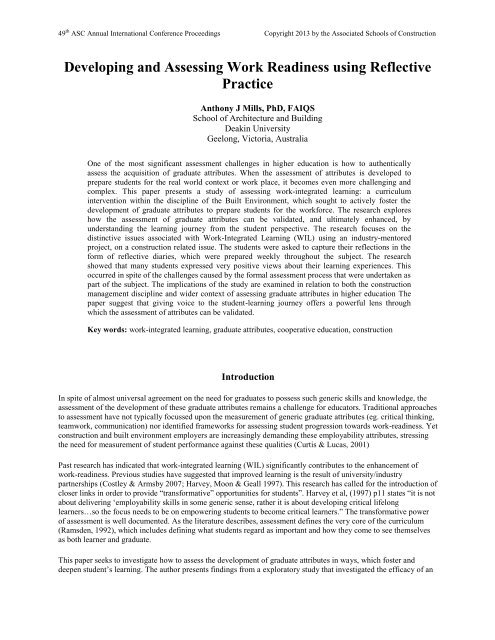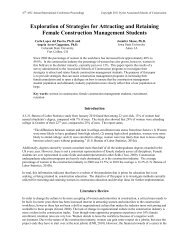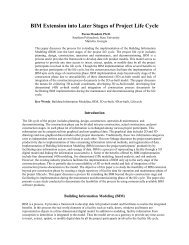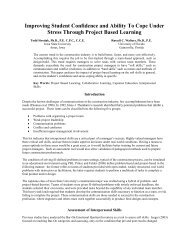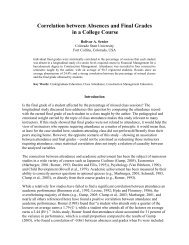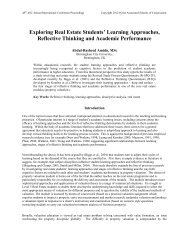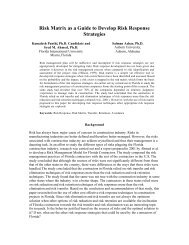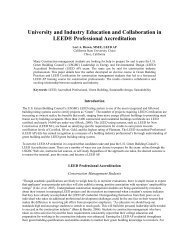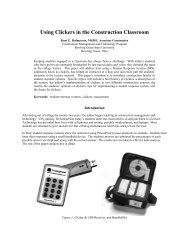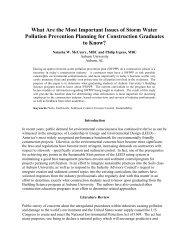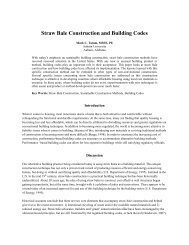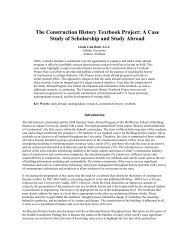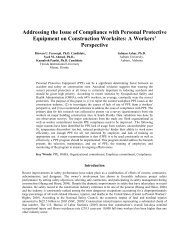Developing and Assessing Work Readiness using Reflective Practice
Developing and Assessing Work Readiness using Reflective Practice
Developing and Assessing Work Readiness using Reflective Practice
Create successful ePaper yourself
Turn your PDF publications into a flip-book with our unique Google optimized e-Paper software.
49 th ASC Annual International Conference Proceedings Copyright 2013 by the Associated Schools of Construction<strong>Developing</strong> <strong>and</strong> <strong>Assessing</strong> <strong>Work</strong> <strong>Readiness</strong> <strong>using</strong> <strong>Reflective</strong><strong>Practice</strong>Anthony J Mills, PhD, FAIQSSchool of Architecture <strong>and</strong> BuildingDeakin UniversityGeelong, Victoria, AustraliaOne of the most significant assessment challenges in higher education is how to authenticallyassess the acquisition of graduate attributes. When the assessment of attributes is developed toprepare students for the real world context or work place, it becomes even more challenging <strong>and</strong>complex. This paper presents a study of assessing work-integrated learning: a curriculumintervention within the discipline of the Built Environment, which sought to actively foster thedevelopment of graduate attributes to prepare students for the workforce. The research exploreshow the assessment of graduate attributes can be validated, <strong>and</strong> ultimately enhanced, byunderst<strong>and</strong>ing the learning journey from the student perspective. The research focuses on thedistinctive issues associated with <strong>Work</strong>-Integrated Learning (WIL) <strong>using</strong> an industry-mentoredproject, on a construction related issue. The students were asked to capture their reflections in theform of reflective diaries, which were prepared weekly throughout the subject. The researchshowed that many students expressed very positive views about their learning experiences. Thisoccurred in spite of the challenges caused by the formal assessment process that were undertaken aspart of the subject. The implications of the study are examined in relation to both the constructionmanagement discipline <strong>and</strong> wider context of assessing graduate attributes in higher education Thepaper suggest that giving voice to the student-learning journey offers a powerful lens throughwhich the assessment of attributes can be validated.Key words: work-integrated learning, graduate attributes, cooperative education, constructionIntroductionIn spite of almost universal agreement on the need for graduates to possess such generic skills <strong>and</strong> knowledge, theassessment of the development of these graduate attributes remains a challenge for educators. Traditional approachesto assessment have not typically focussed upon the measurement of generic graduate attributes (eg. critical thinking,teamwork, communication) nor identified frameworks for assessing student progression towards work-readiness. Yetconstruction <strong>and</strong> built environment employers are increasingly dem<strong>and</strong>ing these employability attributes, stressingthe need for measurement of student performance against these qualities (Curtis & Lucas, 2001)Past research has indicated that work-integrated learning (WIL) significantly contributes to the enhancement ofwork-readiness. Previous studies have suggested that improved learning is the result of university/industrypartnerships (Costley & Armsby 2007; Harvey, Moon & Geall 1997). This research has called for the introduction ofcloser links in order to provide “transformative” opportunities for students”. Harvey et al, (1997) p11 states “it is notabout delivering ‘employability skills in some generic sense, rather it is about developing critical lifelonglearners…so the focus needs to be on empowering students to become critical learners.” The transformative powerof assessment is well documented. As the literature describes, assessment defines the very core of the curriculum(Ramsden, 1992), which includes defining what students regard as important <strong>and</strong> how they come to see themselvesas both learner <strong>and</strong> graduate.This paper seeks to investigate how to assess the development of graduate attributes in ways, which foster <strong>and</strong>deepen student’s learning. The author presents findings from a exploratory study that investigated the efficacy of an
49 th ASC Annual International Conference Proceedings Copyright 2013 by the Associated Schools of Constructionassessment approach that was applied to a work-integrated learning subject within a construction managementdegree. This work-based learning subject was piloted to a small group of eleven who were in the third year (of four)of their undergraduate studies.The research examines the pedagogic implications of going beyond student’s formally assessed learning to examineattribute development as captured via reflective diaries. The authors define attributes to include skills, knowledge,human qualities <strong>and</strong> dispositions (Barnett 2004; Holmes, 2000; Stephenson & Yorke, 1993), <strong>and</strong> view thedevelopment of attributes from the perspective of lifelong learning (Bowden & Marton, 1998; Stephenson & Yorke,1993). The implications of the findings are analysed in relation to pedagogic, challenges <strong>and</strong> opportunities inherentin assessing attributes, <strong>and</strong> which encompass learning beyond traditional university learning experiences. Thefindings of this research will inform the future of the WIL courses in construction management, <strong>and</strong> raise issuesabout the assessment of work-readiness within the wider context of undergraduate education. The next section firstlyoutlines the work skills <strong>and</strong> generic attributes, <strong>and</strong> then secondly describes the student-learning environment used inthis study<strong>Work</strong> Skills <strong>and</strong> Generic AttributesIn the last decade, much attention has been given to the development of graduate attributes in higher education. AsBath <strong>and</strong> Smith (2006) identify, the increasing value placed on attribute development can be attributed to the nowpopular view that education is lifelong, with the increased focus on the relationship between higher education <strong>and</strong>employment outcomes. It is within this context that universities are challenged to develop <strong>and</strong> implement assessmentpractices that can, as Boud <strong>and</strong> Falchikov (2006) advocate, “lay the foundation for a life time of learning” (p.400).Implicit in the expectation that universities will foster generic graduate attributes are that these attributes aretransferable. It is expected that they will prepare students for futures unknown (Bowden & Marton, 1998;Stephenson <strong>and</strong> Yorke, 1993), <strong>and</strong> the assumption that they fill gaps between “the increasing diversity of universitiesas learning sites, <strong>and</strong> the divergence of knowledge within universities that can be bridged” (Barrie <strong>and</strong> Prosser, 2004,p.3). Also, graduate attributes are assumed to be applicable to diverse contexts <strong>and</strong> settings (Barrie & Prosser, 2004;Boud, 2000), <strong>and</strong> commonly encompass characteristics like; critical thinking, problem solving, communicationskills, ethical practice <strong>and</strong>, logical <strong>and</strong> independent thought (Bath, Smith, Stein & Swan, 2004). Past research intothe development of graduate attributes has confirmed, (Bath et. al, 2004; Bath & Smith, 2006; Clanchy & Ballard,1997), that generic attributes are most effectively developed within the context of disciplinary knowledge,“integrated <strong>and</strong> embedded in a curriculum” (Bath, et al., 2004, p. 314).As the literature further identifies, capturing attribute development presents significant pedagogic, conceptual <strong>and</strong>practical challenge for teachers in higher education (Barnett, 2004; Barrie 2005, Bowden & Marton, 1998; Prosser&Trigwell, 1999; Susiman <strong>and</strong> Goodfellow, 2004). Beyond cognitive underst<strong>and</strong>ings, generic attributes introducecomplex conceptualisations of interwoven skills, abilities, affective knowledge <strong>and</strong> dispositions (Fallows & Stevens,2000; James, Lefo & Hadi, 2004). This approach assumes a more learning orientated to assessment (Boud &Falchikov, 2006), <strong>and</strong> presupposes learner engagement in authentic learning settings (Bowden & Marton, 1998;Stephenson & Yorke, 1993). In order to successfully assess the acquisition <strong>and</strong> development of graduate attributes,educators are required to evidence learning which goes beyond the representation of knowledge, to encompass howstudents actually think (Barrie, 2004; Bowden &Marton, 1998; Stephenson & Yorke, 1993). Yet as Barrie (2005)suggests, effectively teaching <strong>and</strong> assessing attributes is difficult in traditional university experiences <strong>and</strong>presupposes learner engagement in authentic learning contexts.Australian universities have in recent years increasingly engaged with industry, professional bodies <strong>and</strong> communities(Costley, 2007; Curtis, 2001; Harvey 1997). A key imperative for this engagement has been to foster <strong>and</strong> evidenceattributes, which will prepare students for their future professional practice through authentic learning experiences.Beyond traditional work placements <strong>and</strong> industrial experience, engagement between universities <strong>and</strong> industry hasseen the emergence of work-integrated learning (WIL). These pedagogies, commonly articulated through university
49 th ASC Annual International Conference Proceedings Copyright 2013 by the Associated Schools of Constructionlearning <strong>and</strong> teaching policy, assume a student centred approach to learning, <strong>and</strong> further challenge still dominantmodels of knowledge <strong>and</strong> content transmission (Usher, 1996).<strong>Work</strong> readiness has become an increasingly important imperative within the discipline of the ConstructionManagement. Similar to the wider workforce, employers within the construction industry expect graduates to possessnot only practical <strong>and</strong> theoretical knowledge, but to also have acquired a suite of generic attributes to ensure thatgraduates are work ready <strong>and</strong> equipped to respond effectively to real world issues (Hager, Holl<strong>and</strong> &Beckett, 2002;Love, Smith & Georgiou, 2003). Such generic attributes include critical thinking, problem solving, ethical <strong>and</strong>socially aware practice, communication <strong>and</strong> negotiation skills, leadership <strong>and</strong> logical <strong>and</strong> independent thought. It isthe assessment of such attributes that we explore in the following sections of this paper. The next section describesthe student-learning environment.Learning EnvironmentThe aim of the subject entitled “ <strong>Work</strong>-integrated Learning in Construction” was to provide a university-centredWIL experience that was mentored by industry. The project took the form of a consulting-type exercise for anindustry client/mentor. The subject was developed as a form of work-integrated learning (WIL), to provide studentswith the opportunity to apply their academic learning to real world problems, situations <strong>and</strong> issues. The purpose ofreflective practice in this instance, was to provide students with an opportunity to develop in-depth reflections oftheir learning experiences.This research project was the second phase of work previously undertaken a year earlier. The results of the firstphase demonstrated that industry had considerable good will towards the concept of WIL. However, the industrialemployers were clear that educational development was not a significant part of the commercial realities of theirown work places. The key results of the previous research project indicated that the construction industry waslooking for the development of WIL in two areas, namely; university-centred assessment processes that includesqualitative advice from industry, <strong>and</strong> robustly tested business-orientated models that provide long-term collaborationopportunities for industrial partners.The current phase of this research was designed to provide a preliminary/exploratory solution to the issuespreviously raised by industry stakeholders (Figure 1). The course was set up to provide a vehicle to develop workreadiness<strong>and</strong> employability skills, <strong>and</strong> was undertaken as a pilot study of 11 enrolled students.UniversityStudentNewsletterAssessment Tasks<strong>Reflective</strong> diary Newsletter Presentation ReportReflexivityProblem solvingTeamworkGlobalperspectiveWrittenCommunicationCriticalThinking<strong>Work</strong>-readygraduateFigure 1: Teachers intended learning journeyThe course comprised 4 types of assessments; reflective diary, newsletter, presentation <strong>and</strong> final report. Theobjective of the assessment was to measure the development of work-ready graduate attributes. The assessment task
49 th ASC Annual International Conference Proceedings Copyright 2013 by the Associated Schools of Construction<strong>and</strong> weights were shown in Table 1. The next section of the paper describes the methodology adopted to explore thedevelopment of graduate attributes.MethodAs qualitative research, the authors employed a grounded theory approach in order to capture <strong>and</strong> discern howstudents, <strong>and</strong> their teachers, perceived attribute development. The research methodology was also informed by aphenomenographical approach since the purpose of the study was to capture how individuals experienced the subjectfrom their own perspective (Akerlind, 2005). The assessment approach utilised in this study, emphasised a formativeapproach. The assessment tasks were designed to facilitate student’s active engagement in learning, to ensure thatthere were opportunities for teacher, industry mentor <strong>and</strong> peer feedback, <strong>and</strong> to provide opportunities for selfassessmentthrough reflection. Other than the reflective diaries, all tasks were undertaken as group work since theteacher sought to create a learning community, “that emphasises social interaction <strong>and</strong> identify over individualaction, collaboration amongst students <strong>and</strong> active engagement in problem solving” (Bath & Smith 2006) p266Following negotiation with the teacher <strong>and</strong> the industry partner/mentor, each group identified a construction-relatedindustry issue: Group One-Occupational Health <strong>and</strong> Safety; Group Two-<strong>Work</strong> Life Balance. Authenticity wasembedded in the assessment tasks, as students were required to investigate the issue in the construction <strong>and</strong> widerregulatory <strong>and</strong> policy contexts, <strong>and</strong> formulate appropriate strategies <strong>and</strong> recommendations for their industrypartner/mentor. Whilst discipline knowledge is not considered to be generic, this attribute was considered by theteacher as fundamental to the outcomes of any undergraduate course, <strong>and</strong> thus included as an intended learningoutcome. In tother words, all with the development of generic attributes, the teacher hoped that the student wouldlearn something about the discipline of construction.<strong>Reflective</strong> diaries were undertaken weekly after each face-to-face session, <strong>and</strong> were supposed to allow students tounpack their experiences, <strong>using</strong> a written blog or diary style. It is not clear whether the “open style free-flowing”approach produced the best reflective practice. Nevertheless, students did use the diaries on a regular basis <strong>and</strong> madeextensive comments about their perceptions <strong>and</strong> experiences. A email was sent to all third years ConstructionManagement students, a total of 11 participants were interviews <strong>and</strong> selected as part of the study; 10 were male <strong>and</strong>1 was female. The aim of the reflective diaries was to provide the student with an opportunity to more deeplyexamine their experiences in the WIL style of the course. But from the teachers perspective the use of reflection wasa challenge to assess. The teacher was new to the use of the diaries, <strong>and</strong> did not direct the students on the best way toreflect, instead encouraging free flowing unstructured comments in their diaries.The teacher also re-examined student’s performance as captured through the formal assessments (assignments eg.newsletter, presentation). In undertaking a personal refection on the assessment practice, the teacher paid particularattention to the degree to which student’s evidenced generic attribute development. The teacher then crossreferencedthe two sources of data (reflective diaries & assignments) to identify the degree of alignment betweenstudent’s perceptions of their attribute development <strong>and</strong> the teacher’s perspective of learning as captured via theassessment. The next section presents the student perspectives <strong>and</strong> the teachers’ reflections in order to provideinsights into the development of generic attributesResultsThe first section explores the teacher’s perspective of the usefulness of the formal assessments in evidencingattribute development. This section also included the results of the Course Evaluation Surveys (CES) completed bythe students as part of the university-wide quality assurance processes. The CES surveys are undertaken <strong>using</strong> ast<strong>and</strong>ard format for all courses offered by the university. This information enables the university to judge the quality
49 th ASC Annual International Conference Proceedings Copyright 2013 by the Associated Schools of Constructionof its courses across the programs, schools <strong>and</strong> the wider university. The second section analysed the intendedstudent learning outcomes, which were planned as part of the assessment process. The reflections were based on rereading<strong>and</strong> analysing the students’ reflective diaries. The re-analysis occurred some months after the completion ofthe course. The author read <strong>and</strong> analysed the transcripts as evidence of attribute developmentThe Teacher PerspectiveAs previously mentioned the assessment tasks were designed to facilitate student’s active engagement in learning, toensure that there were opportunities for teacher, industry <strong>and</strong> peer feedback, <strong>and</strong> to provide opportunities for selfassessmentthrough reflection. Hence, the approach emphasised formative assessment. Whilst discipline knowledgeis not considered to be generic, this attribute was considered by the teacher as fundamental to the outcomes of anyundergraduate program, <strong>and</strong> thus included as an intended learning outcome.Table 1Course AssessmentsAssessment TypeIndustryNewsletter (10%):Investigate industry issue<strong>and</strong> develop a marketing<strong>and</strong> awareness raisingstrategyIntended AttributeDevelopmentTeamwork, disciplineknowledge, critical thinkingproblem solving, professionalcommunicationTeacher perspectiveGroup One: Roles of group membersnot clear. Students struggled to identifyparticular roles within the team, <strong>and</strong> to providepeer-to-peer feedback; approach to industryissue was limited <strong>and</strong> required more in depthanalysis.Project Report(50%): Examine <strong>and</strong>formulate strategies inresponse to industry issue;analyse relevant,contemporary research, <strong>and</strong>analyse issue at the locallevel <strong>and</strong> in relation towider socio political,economic <strong>and</strong> regulatorycontexts, national <strong>and</strong>internationalOral Presentation(20%): Presentation ofproject report to industrypartners, peers <strong>and</strong> wideruniversity community;exchange of ideas withaudience, responsiveness toquestions <strong>and</strong> feedbackTeamwork, disciplineknowledge, critical thinking,problem solving, professionalcommunication, globalperspectiveTeamwork, disciplineknowledge, professionalcommunication; critical thinking,global perspectiveGroup Two: Effectiveness of teamfunction constrained by a lack of cohesionamongst the group; newsletter demonstrated adegree of independent analysis <strong>and</strong> research, butoverall approach <strong>and</strong> analysis was limitedGroup One: Demonstratedunderst<strong>and</strong>ing of discipline knowledge <strong>and</strong>technical content, some critical analysisevidenced, links between report <strong>and</strong> theimplications for the industry beginning to beestablished, effective teamwork not evidenced.Group Two: Similar to group one, withsome further evidence of critical analysis ofcurrent research, <strong>and</strong> greater depth inunderst<strong>and</strong>ing the wider industry contextGroup One: Limited collaboration <strong>and</strong>cooperation between members of the groupevidenced, with inconsistencies in appropriateuse of communication (tenor, mode) displayed,<strong>and</strong> overall limited critical analysis of primary<strong>and</strong> secondary sources.Group Two: Similar to group one, witha heightened degree of awareness of audience
49 th ASC Annual International Conference Proceedings Copyright 2013 by the Associated Schools of Construction<strong>and</strong> context demonstrated, <strong>and</strong> a more analyticalapproach to the industry issue<strong>Reflective</strong> Diaries(20%): Weekly entriesrecording <strong>and</strong> reflecting onlearningReflexivity,communicationStudents did use the diaries on aregular basis <strong>and</strong> made extensive commentsabout their experiences. For the majority ofstudents, diary entries though contained minimalreflections with for some students there was alack of clarity as to the purpose of the reflectivediary evident. Where students did reflect ontheir capability <strong>and</strong> learning this related to theimportance of team work including; their owngroup’s dysfunction, the need to developstrategies when dealing with uncooperative teammembers, <strong>and</strong> the need for more industryexposure <strong>and</strong> analysis of their industry issue.The results (Table 1) show the comments that were provided to students. It may be important to note that due to theexperimental nature of the subject, <strong>and</strong> the small number of students involved. The teacher did not want to motivatestudents <strong>using</strong> a highly structured marking scheme; instead the aim was to reward students who demonstrated abilityto develop deep reflections about their learning experiences. It is well known that this is difficult to achieve inpractice as part of undergraduate education, but it was hoped that under the right conditions it would be possible.Whilst students displayed inconsistent <strong>and</strong>/or limited attribute development through their formal assessments.Particular attributes, such as problem solving <strong>and</strong> teamwork were perceived as having been developed throughoutthe subject; importantly, students did come to know themselves as learners. As the reflections revealed, studentscould be situated across a spectrum of self awareness <strong>and</strong> were to varying degrees able to discern some of the humanqualities, dispositions, skills <strong>and</strong> knowledge they needed to engage effectively as a professional. They did exhibit thebeginnings of what Kember describes as a learning orientation to their education (Kember, 2008 p. 43). This metacognition, lies at the heart of life long learning <strong>and</strong> is a critical determinant of graduate capability (Bowden &Marton, 1998; Maclellan, 2004). Students also demonstrated degrees of transformation in learner identity. Studnetsdid change their thinking from a view of, teacher as expert, to one in which the students were beginning to seethemselves as active participants in their own learning, <strong>and</strong> well as co-creators of new knowledge.In addition, the results of the student surveys were very positive; the overwhelming response from students was thatthey enjoyed the subject <strong>and</strong> were enthusiastic about their experiences. The Course Evaluation Survey (CES), whichwas administered centrally by the university, produced a Good Teaching Score of 95%, which was the highest in theSchool <strong>and</strong> is amongst the best in the university. This encouraging result was evident from not only the surveyscores, but also from written comments made by the students. In particular students were particular pleased with twoaspects of the course, relating to “workplace confidence” <strong>and</strong> “career development”.Although the number of enrolled students is small (n=11), which does not permit any detailed statistical analysis, allenrolled students agreed that the course improved their confidence in tackling unfamiliar problems, with a meanscore 4.4 (of 5). Many positive comments were put forward in the surveys support of this new confidence.“I think that my confidence actually built as I began to meet more (industry) people, so that’s one thing that sort ofgrew out of the course, which was really good.”Other results from the CES survey showed that the course improved their career development. All students believedthat “what they learned could be used in their future career” with a mean score of (4.6 of 5). This was not surprisingbecause the principal aim of WIL was to prepare students for the world of work. However, it is a comfortingoutcome <strong>and</strong> supports the research by Harvey, Moon & Geall (1997) p11 who states “it is not about delivering
49 th ASC Annual International Conference Proceedings Copyright 2013 by the Associated Schools of Construction‘employability skills in some generic sense, rather it is about developing critical lifelong learners” The next part ofthe paper examined the students’ perception of their own work-readiness.The Student PerspectiveThe next part of the analyses examined the reflective diaries of students’ of their own work-readiness. The results(Table 2) show the generic attributes that were considered to be a proxy for the students learning journey.Table 2Student perception of the development of work-readinessGenericAttributeCriticalthinkingSolvingonProblemTeam <strong>Work</strong>Communicati<strong>Reflective</strong>practiceGlobalperspectiveTechnicalknowledgeDescriptive Example“From the reading that I have done about OH&S it seems that“worker attitudes” is one of the major contributing factors to safety in theworkplace. This is a difficult issue that I believe needs to be investigated withregard to the OHS systems put into place”“I believe that I am now more informed <strong>and</strong> aware of the level ofthinking <strong>and</strong> strategy required to formulate a response to an industry issue<strong>and</strong> considered that I am now better placed to deal with an unknown issue inthe future”“Two of the team members, who we have had issues with allsemester, tried to control everyone <strong>and</strong> who took no notice of what othermembers are saying… This was infuriating as we had sent 2 emails toeveryone in the group confirming, timing, attire <strong>and</strong> etc…. I came to therealisation that (the two team members) were not going to adhere to theguidelines (previously agreed) <strong>and</strong> we would have to alter our presentationson the fly”“For some reason some people dread presentations, I on the otherh<strong>and</strong> have no issue with them <strong>and</strong> look forward to giving them, sure I getnervous but it’s all part of the process <strong>and</strong> once I get going I get into a rhythm<strong>and</strong> I’m set. That was my main motivation for taking charge on thepresentation because from the looks from the rest of the group they weren’ttoo keen on it.”In a live lecture you constantly miss out on things because you awriting down something. The lecturer speaks too fast that you don't have timeto write all the important things down. However, hopefully the issues aretaken into consideration whenever we discussed them again this reiterates theimportance of the blog (reflective diary to capture thoughts) <strong>and</strong> how they areused.“(The industry mentor) stated that these days earning a lot of moneydoes not always make up for losing free time, especially for a family man.This is something that I never really thought about, I think it's mainly due tothe fact that I don't have a family with kids to look after”“…. the experience of actually applying theory to practice <strong>and</strong> togaining direct feedback from industry improved my underst<strong>and</strong>ing of the(technical) issues”The following discussion relates to the data in Table 2
49 th ASC Annual International Conference Proceedings Copyright 2013 by the Associated Schools of ConstructionCritical Thinking: Critical analysis <strong>and</strong> independent thought was considered vital to successfully meeting theobjectives of the group report <strong>and</strong> group presentation. Broadly, the students who identified a heightened awarenessof Critical Thinking defined this attribute as encompassing the analysis of diverse sources of data, the capacity todistil information according to reliability, validity <strong>and</strong> currency.The role of the WIL course was to provide an environment that encouraged critical thinking. The results of pastresearch (Mills, A, McLaughlin & Robson 2008) showed that employers believed that gradates displayed an overlyuncritical view of the world that could be construed as being almost naive. While this is not surprising especially forstudents that have not worked before in industry, it represented an opportunity to introduce them to some of thewider views <strong>and</strong> issues that will confront them when they join the world-of-work.Problem solving: Broadly, all students perceived that they had developed a deeper underst<strong>and</strong>ing of the qualities <strong>and</strong>skills required to address problem solving. Students perceived that their problem solving ability had been enhancedprimarily because they had experienced dealing with uncertainty, ambiguity <strong>and</strong> complexity in a real life situation onthe ground. All students identified that they had developed their ability to undertake independent research, with onestudent identifying that this was an area that he or she needed to develop more fully in the future.Team <strong>Work</strong>: Whilst the students expressed their misgivings about their team’s performance, <strong>and</strong> perceived that therewas a lack of cohesion across their group, they also perceived that they had developed a heightened awareness <strong>and</strong>underst<strong>and</strong>ing of team work as social practice, <strong>and</strong> of the factors which both impede, <strong>and</strong> enable, effective teamfunction.Communications: The course did seem to encourage the development of communication, both written <strong>and</strong> verbal.Students said that overall they enjoyed the experience that the report <strong>and</strong> presentation provided <strong>and</strong> believed that ithad development them as individuals. However, not all students had done presentations in the past, so it becameclear that there were different levels of experience within the groups.Global Perspective: Most students had some underst<strong>and</strong>ing of wider industry <strong>and</strong> global contexts. For thesestudents, increased underst<strong>and</strong>ings of current <strong>and</strong> emerging industry needs <strong>and</strong> trends, <strong>and</strong> of the economic <strong>and</strong>regulatory drivers that shape industry practice were identified as having been developed.Technical Knowledge: All students identified that their underst<strong>and</strong>ing of discipline knowledge had been broadened<strong>and</strong> enhanced. As an example, one student attributed this to gaining the experience of actually applying theory topractice <strong>and</strong> to gaining direct feedback from industry. For others they suggested that it enhanced underst<strong>and</strong>ings ofthe discipline knowledge were also attributable to the opportunities provided through the course to gain directfeedback from industry partners.In summary the students through their diary entries, expressed a range of views that indicated that they did developgraduate attributes. It is reasonable to suggest that the attribute development was not uniform across all students butthere was some evidence that each student had positive sentiments about their learning journey. The next section ofthe paper examines some of the issues involved with the development of graduate attributes in trying to accuratelydetermine if work-readiness was being developed.DiscussionThe research was the second phase of a earlier study, which explored the employers perspectives of WIL. (Mills et al., 2008). Results of the previous research showed that industrial employers were not equipped at assessingeducational development in their work places. The key results of the previous project indicated that the constructionindustry was looking for the development of WIL in two areas, namely; university-centred assessment processes thatincludes qualitative advice from industry. The educational model used in this study was designed to address issue ofworkplace assessment.
49 th ASC Annual International Conference Proceedings Copyright 2013 by the Associated Schools of ConstructionSuch preparation <strong>and</strong> guidance includes explicitly modelling the practice of reflection for students, building onstudent’s learning <strong>and</strong> fostering a learning climate in which students are supported to share their experiences withtheir teacher, peers <strong>and</strong> other learning partners. Actively fostering student’s capacity for reflection was necessary forstudents in the study, as they required a more teacher-guided approach to support reflective practice. Activities suchas guided debriefing sessions <strong>and</strong> self-assessments offering a mechanism to enable <strong>and</strong> support student’s criticalreflections. Guiding the process of reflection by, for example, providing prompts or a series of reflective questionsfor students to respond to at different stages of their learning, would have similarly provided a learning frameworkupon which students capacity for reflective practice could have been identified <strong>and</strong> built upon.Student’s prime motivation to undertake the subject was to make industry contacts <strong>and</strong> enhance their employabilityprospects after graduation. Yet, at the conclusion of the course, students demonstrated an explicit <strong>and</strong> deeperawareness of both the value of attributes, in relation to employability, but beyond this to their personal development<strong>and</strong> future learning.From the teacher’s perspective, the assessment of attributes had presented significant challenges that included how toknow the level of a student’s capability at the commencement of the course; <strong>and</strong> how to measure attributes that areinterwoven clusters of skill, knowledge, dispositions <strong>and</strong> ability. Findings from the study reinforce both therecognised need for assessment to be consistent with the teaching approach (Biggs, 2003; Kember, 2008; Ramsden,1992), <strong>and</strong> for teachers <strong>and</strong> students to engage in a discursive dialogue to nurture critical reflection through theexchange of skills, knowledge <strong>and</strong> practice to inform identity.The teacher had assumed that students would embrace opportunities for self managed learning, <strong>and</strong> that they wouldbring to the assessment tasks a capacity to direct <strong>and</strong> reflect on their learning <strong>and</strong> a developed awareness of workingwith others. This research showed that while this was evidenced in the diaries of some students it was not universalacross the group. The findings of the study reinforced the importance of preparing <strong>and</strong> guiding students through theprocess of reflection that, as Boud (2001) identifies, is vital to successfully engaging students in critical reflectivepractice. This is particularly so for students being introduced to reflective practice as was the case in the electivediscussed here.As the literature identifies, building a rapport <strong>and</strong> coherence across a learning community is also vital to supportingself-reflection (Kember, 2008) <strong>and</strong> to stimulating the development of higher order capabilities. Student’s levels ofcomfort with the notion of teacher as expert, <strong>and</strong> levels of discomfort with the student-centred learning approachadopted in this study, were in part the result of their past undergraduate experiences of assessment. This impacted onstudent’s performance in their assessments <strong>and</strong> confirms the importance of shifting the assessment from a traditionalsummative form to a reflective formative approach. The challenges this presents for teachers in higher education arehighly complex <strong>and</strong> compounded further in the mass education environment. Further research is necessary todevelop mechanisms to support change in the teaching <strong>and</strong> learning practices in order to facilitate better educationaloutcomes for students <strong>and</strong> society in general. This remains a challenge for university education which has had anover reliance on traditional approaches to teaching, learning <strong>and</strong> assessment.ConclusionsIn higher education research there is a growing interest in the importance of work-integrated learning, which isdefined as linking learning to the roles in work. The significance of this research was that it demonstrated that theassessment of such skill development is challenging <strong>and</strong> is awkward <strong>using</strong> traditional assessment modes. Findingsfrom the study also suggest a possible lack of coherence <strong>and</strong> integration in the development of work-readiness acrossthe wider Built Environment programs, since program coherence is fundamental to the development of graduateattributes.
49 th ASC Annual International Conference Proceedings Copyright 2013 by the Associated Schools of ConstructionThe results suggest that the process of capturing the student perspective through the assessment practice offered richinsights into attribute development including the evidencing of unintended learning, <strong>and</strong> enabled complex <strong>and</strong>interconnected dimensions of achievement. The findings will inform the on-going development of the WIL <strong>and</strong>suggest that further research is needed to explore the assessment of graduate attributes. So too is research whichsystematically explores the symbiotic relationship between authentic learning <strong>and</strong> discipline-based constructionknowledge, a snapshot of which was captured by the study.The development of professional competence in practice of construction management is an important issue. It iscommon concern that; in these days of cost cutting, decreasing resources, <strong>and</strong> increased student numbers, thatdeveloping students as reflective practitioners may be viewed as an unaffordable luxury. The importance of thispaper is that it suggests the reflective practice can helps equip the graduate with the competencies necessary to meetthe challenges of a changing world.ReferencesAkerlind, G. (2000).Variation <strong>and</strong> Commonality in phenomenographic research methods. Higher EducationResearch & Development, 24 (4), 321-334.Barnett, R. (2004). Learning for an unknown future. Higher Education Research <strong>and</strong> Development, 23 (3), pp. 247-260Barrie, S C. (2004). ‘Academics Underst<strong>and</strong>ings of Generic Attributes: a Framework for Assuring Quality’. Paperpresented at the Australian Universities Quality ForumBarrie, S. C. (2005). Rethinking Generic Graduate Attributes. Higher Education Research <strong>and</strong> Development Societyof Austrlasia, 27(1), 1-6.Barrie, S. C., & Prosser, M. (2004). Generic graduate attributes: citizens for an unknown future. Higher EducationResearch <strong>and</strong> Development, 23(3), 1-8.Bath, D, & Smith, C, Stein, S & Swann, R. (2004). Beyond mapping <strong>and</strong> embedding graduate attributes: bringingtogether quality assurance <strong>and</strong> action learning to create a validated <strong>and</strong> living curriculum. Higher EducationResearch & Development, 23 (3), 313-326.Bath, D & Smith, C. (2006). The role of the learning community in the development of discipline knowledge <strong>and</strong>generic graduate outcomes. Higher Education, 51, 259-286.Biggs, J. (2003). Teaching for Quality Learning at University. Buckingham: The Society for Research into HigherEducation & Open University PressBoud, D. (2000). Sustainable assessment: rethinking assessment for the learning society. Studies in ContinuingEducation, 22 (2), 151-167.Boud, D. (2001). Using journal writing to enhance reflective practice. In English, L.M.& Gillen, M. A. (Eds.)Promoting Journal Writing in Adult Education. New Directions in Adult <strong>and</strong> Continuing Education No. 90. SanFrancisco: Jossey-Bass, 9-18.Boud, D & Falchikov, N. (2006).Aligning assessment with long-term learning. Assessment & Evaluation in HigherEducation, 31 (4), 399-413.Bowden, J & Marton, F. (1998). The University of Learning: Beyond Quality <strong>and</strong> Competence in Higher Education.London: Kogan Page
49 th ASC Annual International Conference Proceedings Copyright 2013 by the Associated Schools of ConstructionClanchy, J., & Ballard, B. (1995). Generic skills in the context of higher education. Higher Education Research <strong>and</strong>Development, 14(2), 155-166.Costley, C & Armsby, P (2007). '<strong>Work</strong>-based learning assessed as field or mode of study', Assessment <strong>and</strong>Evaluation in Higher Education, vol. 32, no. 1, pp. 21-33.Curtis, S & Lucas, R (2001). 'A coincidence of needs?: Employers <strong>and</strong> full-time students', Employee Relations,MCB Press, vol. 23, pp. 38-54.Fallows, S & Stevens, C (2000). Integrating Key Skills in Higher Education. London: Kogan PageHager, P., Holl<strong>and</strong>, S., & Beckett, D. (2002). Enhancing the Learning <strong>and</strong> Employability of Graduates. The Role ofGeneric Skills. B-HERT Round Table Position Paper No. 9. Melbourne, Australia.Harvey, L, Moon, S & Geall, V (1997). Graduates <strong>Work</strong>: Organisational change <strong>and</strong> students attributes, Centre forResearch into Quality, Birmingham, UK.Harvey (1997).Holmes, L. (2000). Questioning the Skills Agenda. In S. Fallows & C. Steven (Eds.), Integrating Key Skills inHigher Education: Employability, Transferable Skills <strong>and</strong> Learning for Life (pp. 201-214). London: Kogan Page.James, B., Lefoe, G., & Hadi, M. (2004). Transforming Knowledge into Wisdom: Holisitic Approaches to Teaching.Retrieved June 20, 2009, from http://herdsa2004.curtin.edu.my/Contributions/Refereed/Papers.htmJessop, T (2008). ‘If we miss a deadline, we get 40. If they miss a deadline they still get paid’ HEA Annualconference: 2 July University of WinchesterJones, J. (2000). Generic Attributes: an Agenda for Reform or Control. Retrieved August 26 2006, fromhttp://learning.uow.edu.au/LAS2001/selected/jones_2.pdf.Kember, D (2008). Nurturing generic capabilities through a teaching <strong>and</strong> learning environment which providespractise in their use. Higher Education, 57, 37-55Love, P, Smith, J & Georgiou, J. (2003). 'Building a symbolic relationship between academia <strong>and</strong> industry:Expectations <strong>and</strong> observations of construction management graduates', paper presented to AUBEA 2003: <strong>Work</strong>ingtogether, Deakin University, Geelong, Victoria, 9-11 July 2003Maclellan, E (2004). Authenticity in assessment tasks: a heuristic exploration of academics’ perceptions. HigherEducation Research & Development, 23 (1), 19-33Mills, A, McLaughlin, P & Robson, K 2008, 'Employers’ Perspectives On <strong>Work</strong>-Integrated Learning In Project-Based <strong>Work</strong>places', in World Association of Collaborative Education conference, hosted by ACEN, Manly, Sydney,pp. 412-9.Palmer, S (2004). Authenticity in assessment reflecting undergraduate study <strong>and</strong> professional practice. EuropeanJournal of Engineering Education, 29 (2), 193-202Prosser, M., & Trigwell, K. (1999). Underst<strong>and</strong>ing Learning <strong>and</strong> Teaching. Buckingham: The Society for Researchinto Higher Education & Open University Press.Ramsden, P (1992). Learning to teach in Higher Education. Routledge. LondonStephenson, J & Yorke, M. (1998). Capability <strong>and</strong> Quality in Higher Education London: Kogan PageUsher, R. (1996). A Critique of the Neglected Epistemological Assumptions of Educational Research. In D. Scott &Usher (Eds.), Underst<strong>and</strong>ing Educational Research. London: Routledge.


